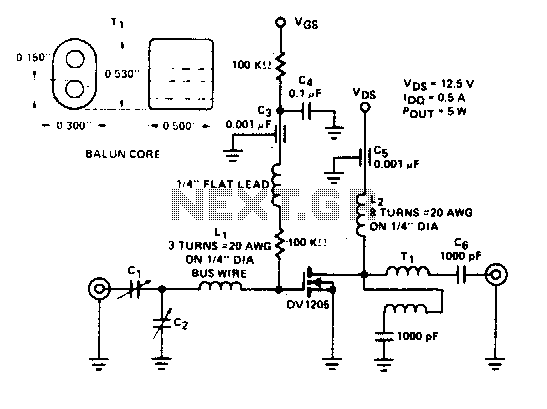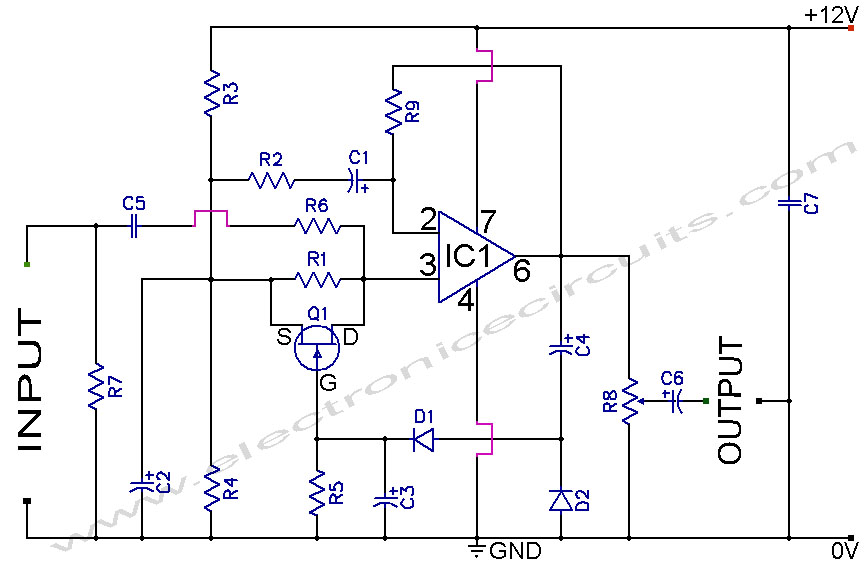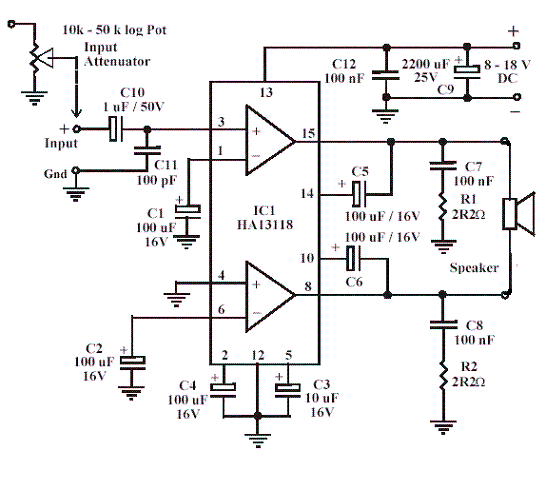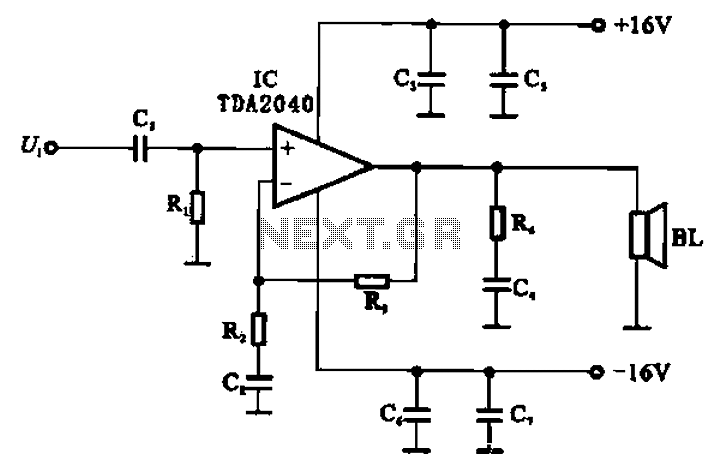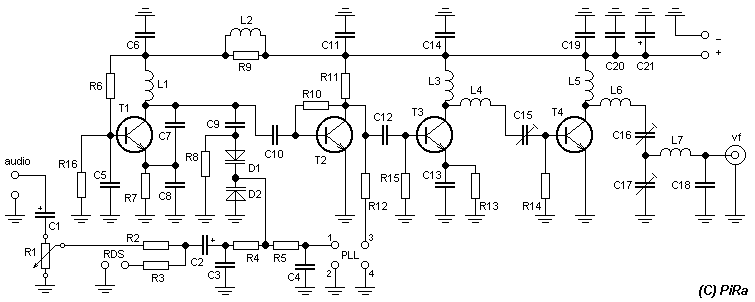
2SC1946A 30 Watt VHF Amplifier

The 30-watt amplifier schematic provided below offers a power boost from an input of 4 watts to 6 watts. This circuit is designed to operate within the 88-108 MHz FM broadcast band. It demonstrates stability and delivers a clean output through a seven-element Butterworth low-pass filter. The core component of the circuit is the 2SC1946A, a VHF RF power transistor designed for operation at frequencies up to 175 MHz, yielding excellent performance. The power line exhibits effective decoupling, and the amplifier's current can exceed 5 amps. All coils are constructed from 16-gauge laminated wire, although silver copper wire is preferable. The RF choke (RFC) can utilize an HF toroid core or a ferrite bead with six holes. Capacitor C3 and resistor R1 form a snubber circuit, while resistor R2 and capacitor C6 prevent self-oscillation at VHF frequencies. In some cases, adding a 180-ohm resistor in parallel with inductor L7 may be necessary to reduce undesired VHF emissions and lower spurious levels. The accompanying photo illustrates a 60-watt VHF power amplifier based on this circuit, featuring two 2SC1946A transistors arranged at 90 degrees to each other, with their outputs combined using a power combiner network. Combining power at VHF and UHF bands is notably challenging; therefore, it is advisable for hobbyists to utilize a single power design to avoid complexity and minimize interference risks associated with dual transistor configurations, where the amplifiers operate out of phase. Tuning the amplifier is straightforward; connecting the output to a suitable antenna with a 50-ohm transmission line (RG214) is essential. First, match the output network, followed by the input network, to achieve maximum power output. Adjustments can be made to enhance the output at the desired operating frequency.
The 30-watt amplifier circuit is a well-engineered design suitable for FM broadcasting applications. The 2SC1946A transistor serves as the primary amplification element, chosen for its high frequency and power handling capabilities. This transistor's characteristics ensure that the amplifier remains stable under varying load conditions, which is crucial for maintaining audio fidelity in broadcasting.
The inclusion of a seven-element Butterworth low-pass filter is significant, as it effectively attenuates unwanted harmonic frequencies, ensuring that the output remains clean and compliant with broadcasting regulations. The design's attention to decoupling in the power line is critical, as it minimizes noise and interference that could affect performance.
The construction of the coils from 16-gauge laminated wire or silver copper wire contributes to the overall efficiency of the amplifier. The choice of materials and construction techniques directly impacts the amplifier's performance, particularly in high-frequency applications. The use of an HF toroid core or ferrite bead for the RF choke is a common practice in RF design, as these components help maintain signal integrity while minimizing losses.
The snubber circuit formed by C3 and R1 plays a vital role in protecting the amplifier from voltage spikes, while R2 and C6 are essential for stabilizing the circuit and preventing oscillations that could lead to signal distortion. The optional addition of a 180-ohm resistor in parallel with L7 demonstrates the design's flexibility, allowing for fine-tuning to optimize performance.
The description of the 60-watt VHF power amplifier highlights the scalability of this design. By utilizing two 2SC1946A transistors, the circuit can achieve higher power outputs, although this introduces complexity through the need for a power combiner network. This aspect emphasizes the importance of careful design consideration when scaling power levels in RF applications.
Overall, this amplifier circuit is a robust solution for FM broadcasting, with a focus on stability, efficiency, and clean output. Proper tuning and matching of the input and output networks are essential steps in the setup process, ensuring optimal performance and maximizing the amplifier's capabilities.The 30 watt amplifier schematic shown below provides an appropriate power boost with an input of 4 watt up to 6 watts. The circuit is designed to cover 88-108MHz FM Broadcast Band. However, the circuit is very stable at my place and provides a clean-output through seven (7) element Butter-worth low-pass filter.
The heart of the circuit is 2SC1946A VHF RF power transistor. The transistor is specifically designed for operation in frequencies up to 175 MHz, with very good results. As you can see, the power line is well decoupled. The amplifier current can be over 5 amps. All the coils are made from 16gauge laminated wire (or Silver copper wire can do best) and the RFC can be of HF toroid core (as shown in the picture) or 6 holes ferrite bead.
C3 and R1 forms snubber circuit while R2 and C6 prevent the amplifier from self-oscillation at VHF, sometimes you need to add 180 ohms in parallel with L7. That will cause the amplifier to dissipate UNDESIRABLE VHF thereby reducing spurious level. The photo below is 60Watts VHF power amplifier using the above circuit. Two of 2SC1946A transistors are arranged at 90 degrees to each other and their outputs are combined using "Power Combiner Network`.
It is quite difficult to combine powers at VHF and UHF bands. However, I recommend that hobbies should stick to single power design due to its complicity and large rate of INTERFERENCE. (in attempt to go for double transistors which involves power combiner network). Since the two amplifiers are operating in different phase (out of phase). Tuning of the amplifier is not hard at all. You just have to connect the output to a good antenna with a transmission line (RG214) of 50 ohms. First match the output network, and then do the same to the input network for a maximum power output.
By way of adjustment, you can increase the output at its operating frequency. 🔗 External reference
The 30-watt amplifier circuit is a well-engineered design suitable for FM broadcasting applications. The 2SC1946A transistor serves as the primary amplification element, chosen for its high frequency and power handling capabilities. This transistor's characteristics ensure that the amplifier remains stable under varying load conditions, which is crucial for maintaining audio fidelity in broadcasting.
The inclusion of a seven-element Butterworth low-pass filter is significant, as it effectively attenuates unwanted harmonic frequencies, ensuring that the output remains clean and compliant with broadcasting regulations. The design's attention to decoupling in the power line is critical, as it minimizes noise and interference that could affect performance.
The construction of the coils from 16-gauge laminated wire or silver copper wire contributes to the overall efficiency of the amplifier. The choice of materials and construction techniques directly impacts the amplifier's performance, particularly in high-frequency applications. The use of an HF toroid core or ferrite bead for the RF choke is a common practice in RF design, as these components help maintain signal integrity while minimizing losses.
The snubber circuit formed by C3 and R1 plays a vital role in protecting the amplifier from voltage spikes, while R2 and C6 are essential for stabilizing the circuit and preventing oscillations that could lead to signal distortion. The optional addition of a 180-ohm resistor in parallel with L7 demonstrates the design's flexibility, allowing for fine-tuning to optimize performance.
The description of the 60-watt VHF power amplifier highlights the scalability of this design. By utilizing two 2SC1946A transistors, the circuit can achieve higher power outputs, although this introduces complexity through the need for a power combiner network. This aspect emphasizes the importance of careful design consideration when scaling power levels in RF applications.
Overall, this amplifier circuit is a robust solution for FM broadcasting, with a focus on stability, efficiency, and clean output. Proper tuning and matching of the input and output networks are essential steps in the setup process, ensuring optimal performance and maximizing the amplifier's capabilities.The 30 watt amplifier schematic shown below provides an appropriate power boost with an input of 4 watt up to 6 watts. The circuit is designed to cover 88-108MHz FM Broadcast Band. However, the circuit is very stable at my place and provides a clean-output through seven (7) element Butter-worth low-pass filter.
The heart of the circuit is 2SC1946A VHF RF power transistor. The transistor is specifically designed for operation in frequencies up to 175 MHz, with very good results. As you can see, the power line is well decoupled. The amplifier current can be over 5 amps. All the coils are made from 16gauge laminated wire (or Silver copper wire can do best) and the RFC can be of HF toroid core (as shown in the picture) or 6 holes ferrite bead.
C3 and R1 forms snubber circuit while R2 and C6 prevent the amplifier from self-oscillation at VHF, sometimes you need to add 180 ohms in parallel with L7. That will cause the amplifier to dissipate UNDESIRABLE VHF thereby reducing spurious level. The photo below is 60Watts VHF power amplifier using the above circuit. Two of 2SC1946A transistors are arranged at 90 degrees to each other and their outputs are combined using "Power Combiner Network`.
It is quite difficult to combine powers at VHF and UHF bands. However, I recommend that hobbies should stick to single power design due to its complicity and large rate of INTERFERENCE. (in attempt to go for double transistors which involves power combiner network). Since the two amplifiers are operating in different phase (out of phase). Tuning of the amplifier is not hard at all. You just have to connect the output to a good antenna with a transmission line (RG214) of 50 ohms. First match the output network, and then do the same to the input network for a maximum power output.
By way of adjustment, you can increase the output at its operating frequency. 🔗 External reference
